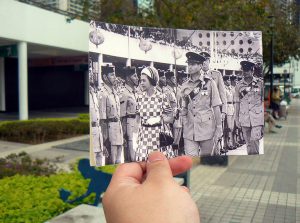
Building on Disappearance
In his essay “Hong Kong: Culture and the politics of disappearance”, Ackbar Abbas examines the disappearance of colonial buildings and colonial history. The writer highlights the importance of the preservation process by depicting the importance of architecture as visual evidence of the city’s identity. He then links to three examples of preservation cases, which are misled, in Hong Kong to emphasize how true values of colonial identity have crumbled down. One notable example is the Repulse Bay hotel. First built in 1920 and remodeled in early 1982, the Repulse Bay has transformed from grand colonial style building to modernized luxurious apartment blocks. Although the Repulse Bay has won Hong Kong’s premium architectural award as it has combined the “old” and “new”, it is hard to say it was an act of preservation: there is a clear contrast in architectural style.
Frankly, it is hard to say the reconstruction of Repulse Bay was a mistake. Due to the rapid development in technology we cannot deny the change in trend. Buildings now have more modernized and sharp looks and people like them.
Although Ackbar Abbas is right about the disappearance of colonial history in Hong Kong, I believe it is a factor we have to embrace as time passes. Society has to adapt as there is always a problem. We evolve through problem-solving and upgrade our lifestyle. The same logic applies to architecture. Crumbling the olds and constructing the news is not an act of destruction and construction but an act of evolution. Skylines and buildings transform into a more aesthetically appealing form.
I am not asserting that we forget the past and move on. Preservation is needed and we need to remember the past, but leaving the architecture in an old fashioned way is not the best and only solution. We can utilize modern industry such as film and entertainment. We keep track of changing skylines and architecture in motion films. Preservation method can also evolve in a new manner.
Yu Chungha UID: 3035553135


Your personal views on the Repulse Bay Hotel renovation project are dominant and well presented in your reading respond, hence it clearly serves as a representation of your views on preservation. The only constructive feedback I would like to add is that you need to mention your image source. It’s a brilliant image, as it highlights issues raised in your text, and because of that I am even more curious to know from which time this image of Queen Elizabeth II is. Overall, well done; keep the good work up.
I definitely agree with you that film and architecture should evolve along with time. It is great that you have acknowledged the divided needs of preservation and modernization at the same time, but it may be better if you have any examples of films that have done so. Film can effectively portray a director’s image a city, but how to we represent multiple images of one city through film?